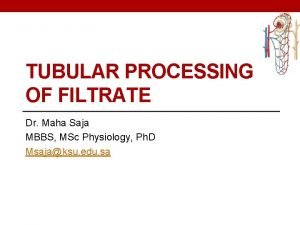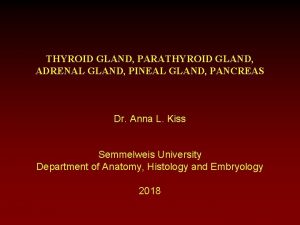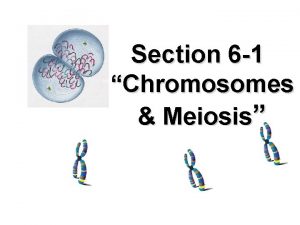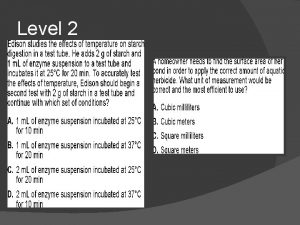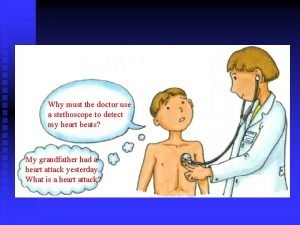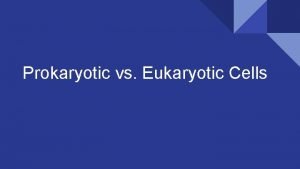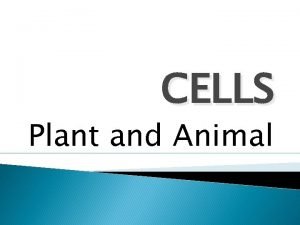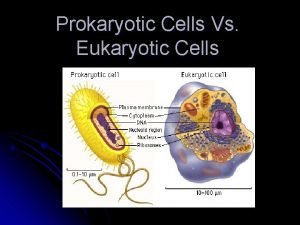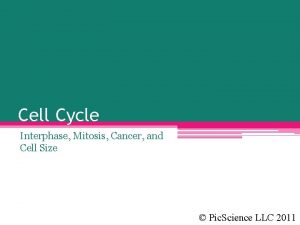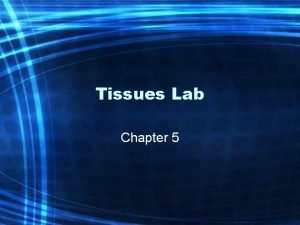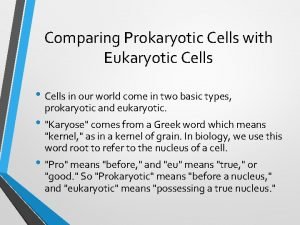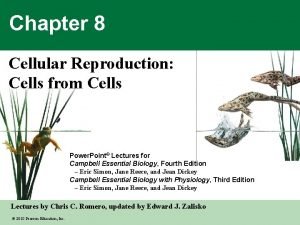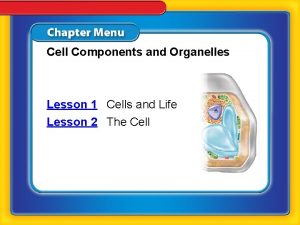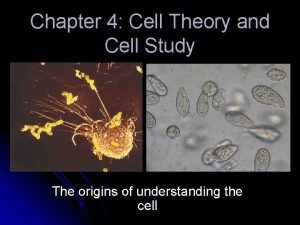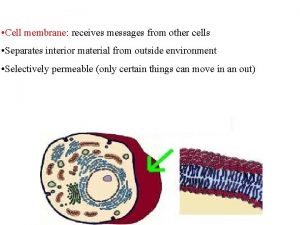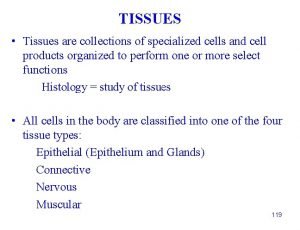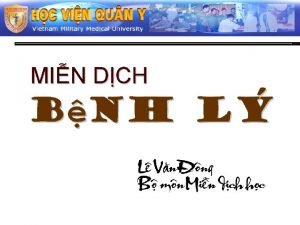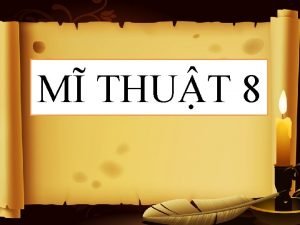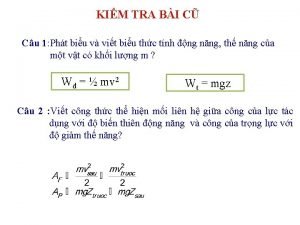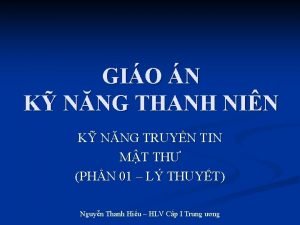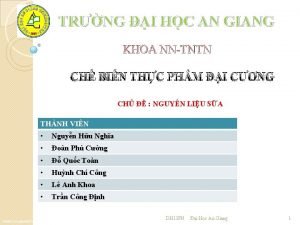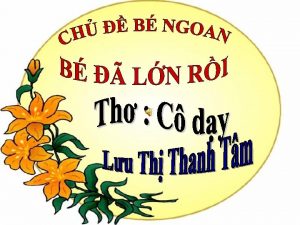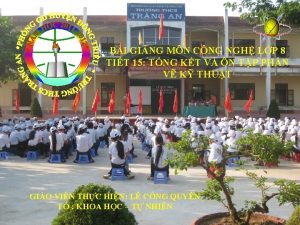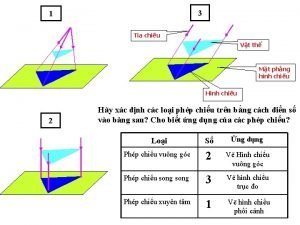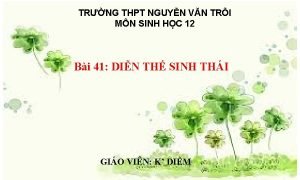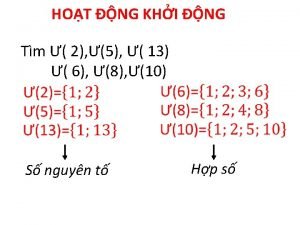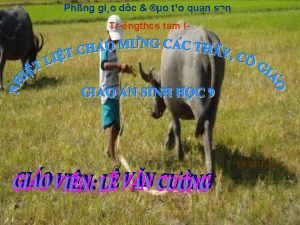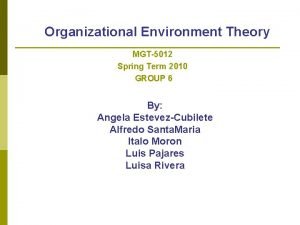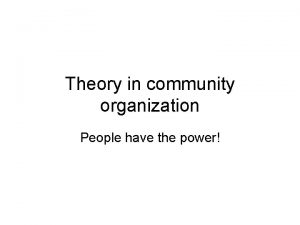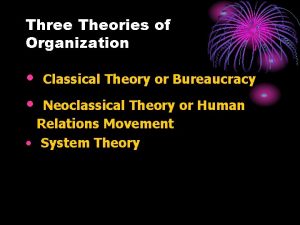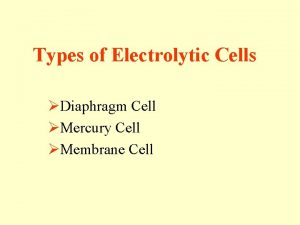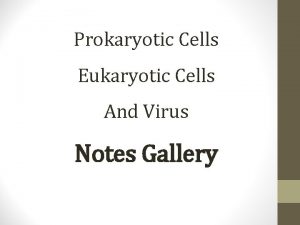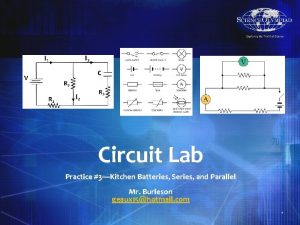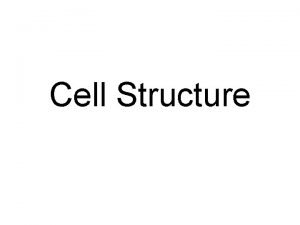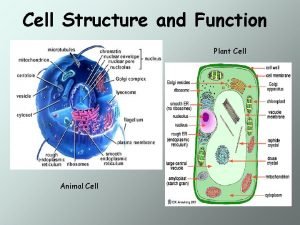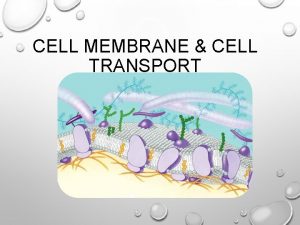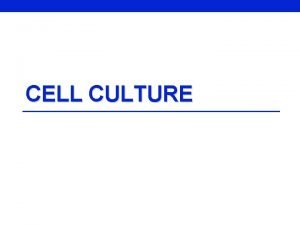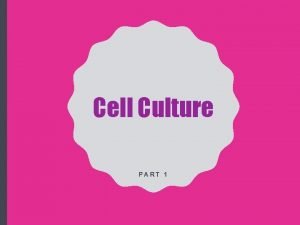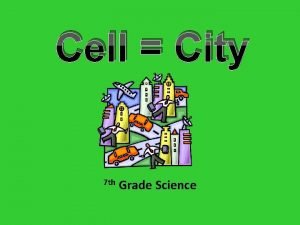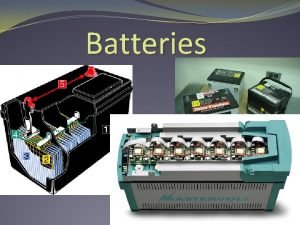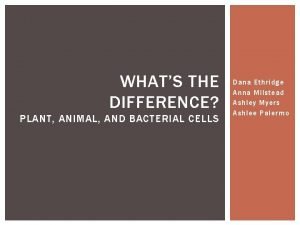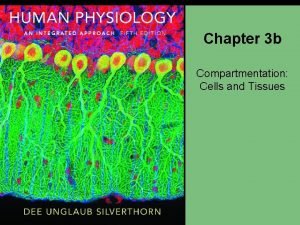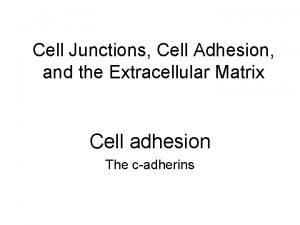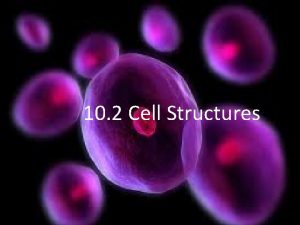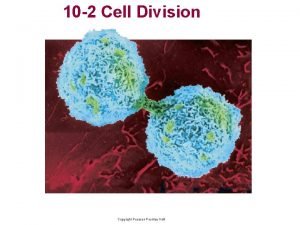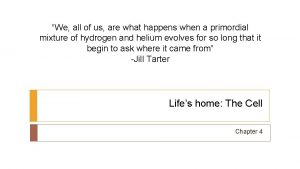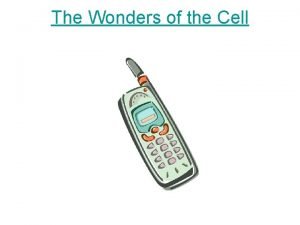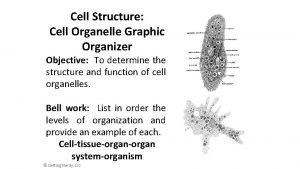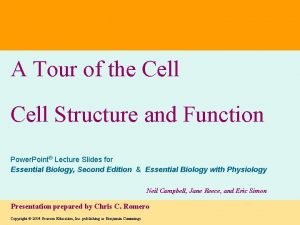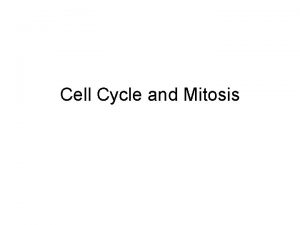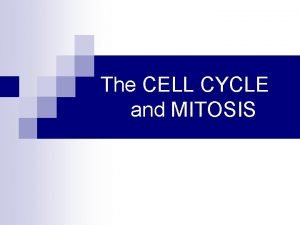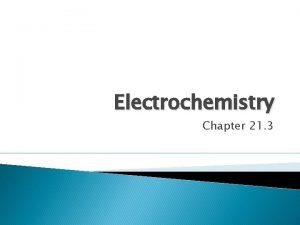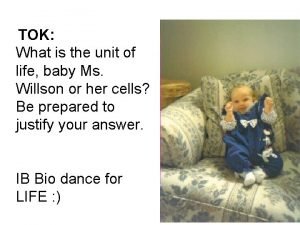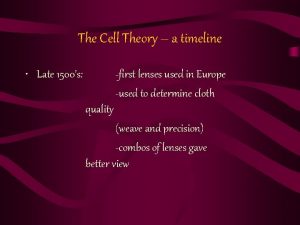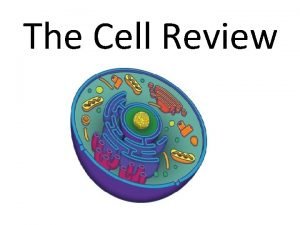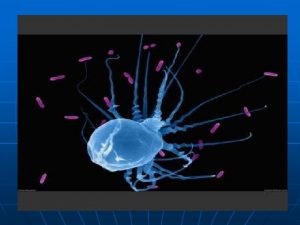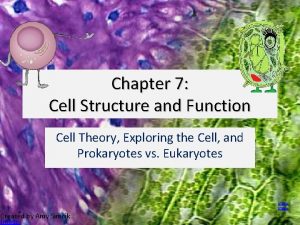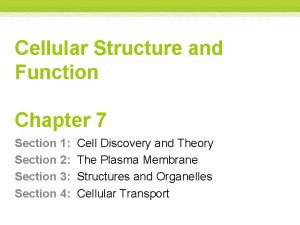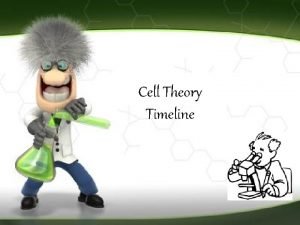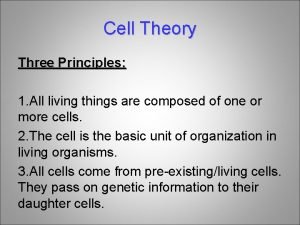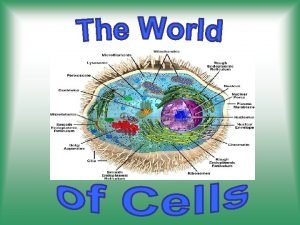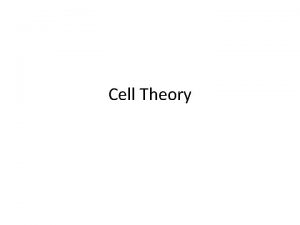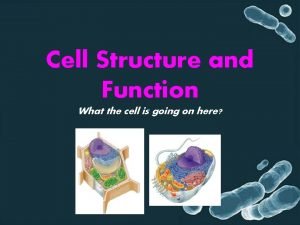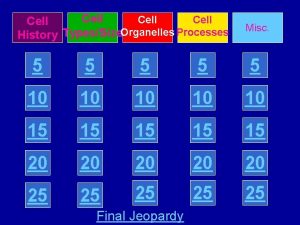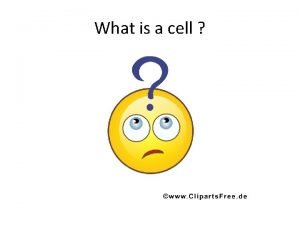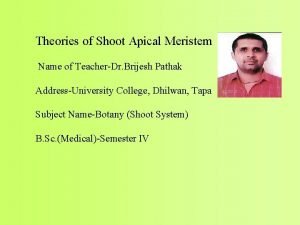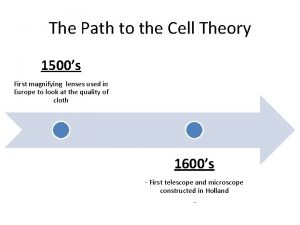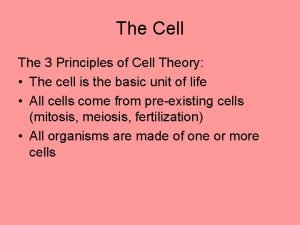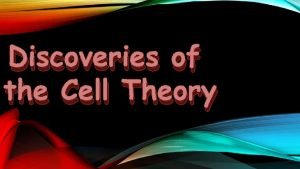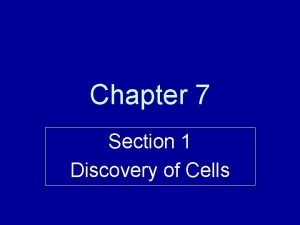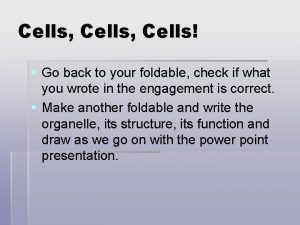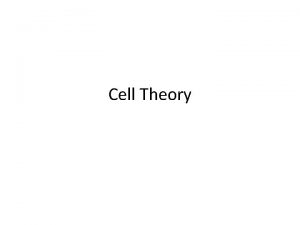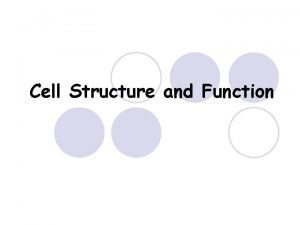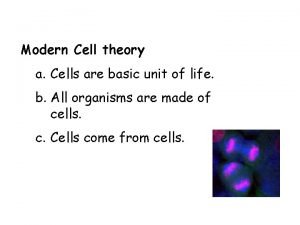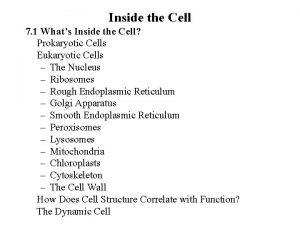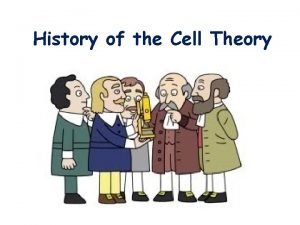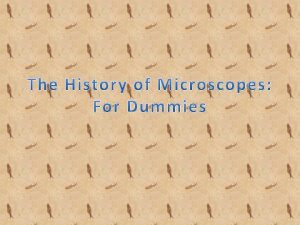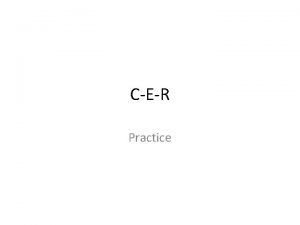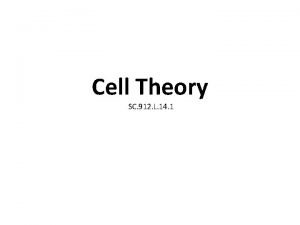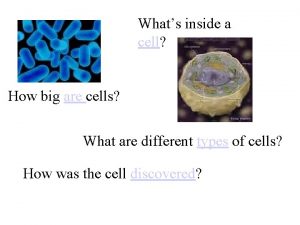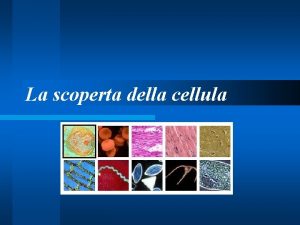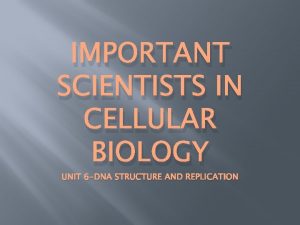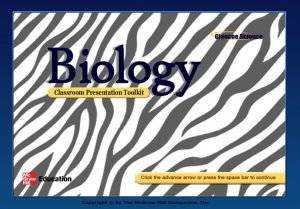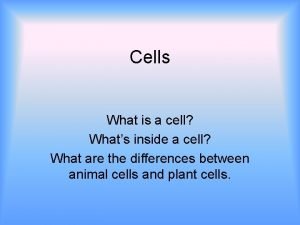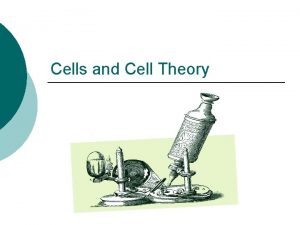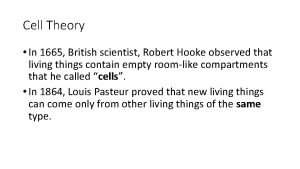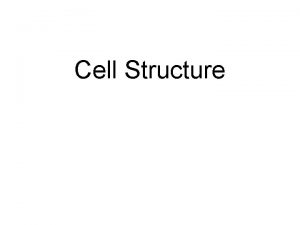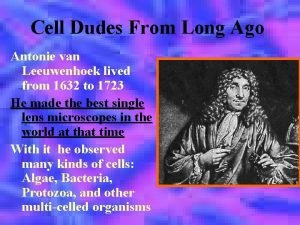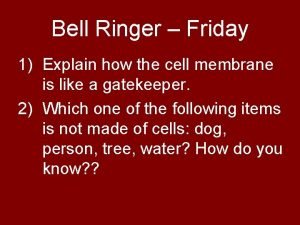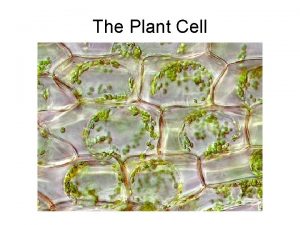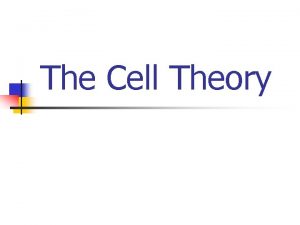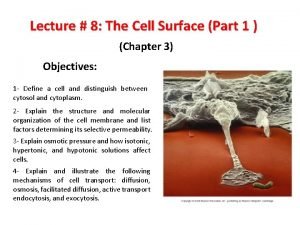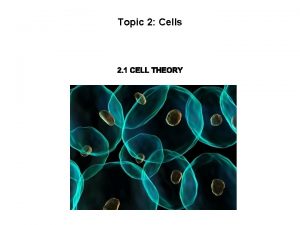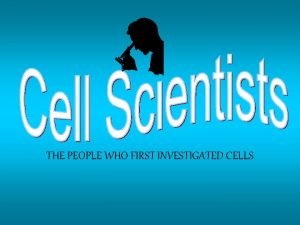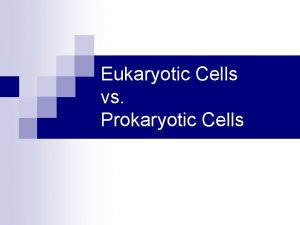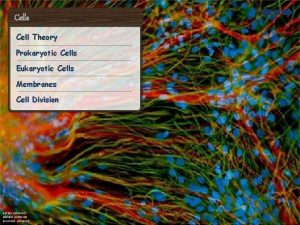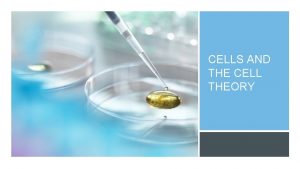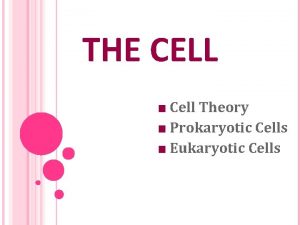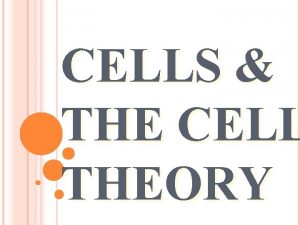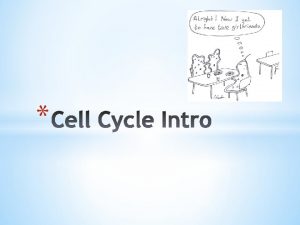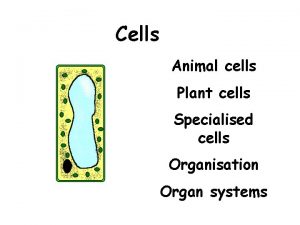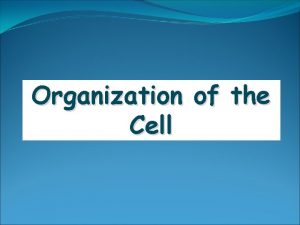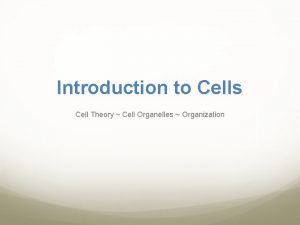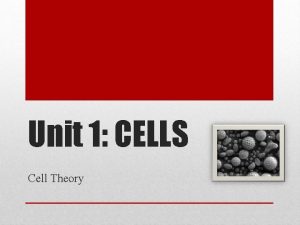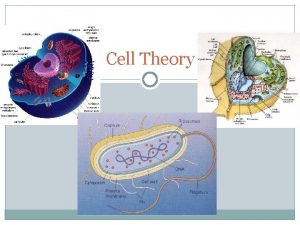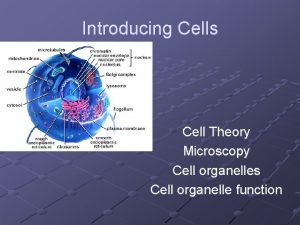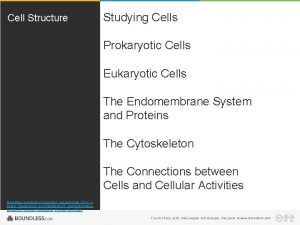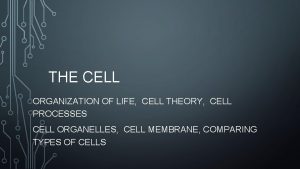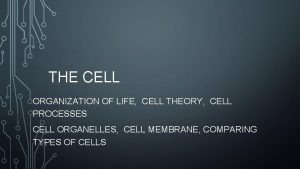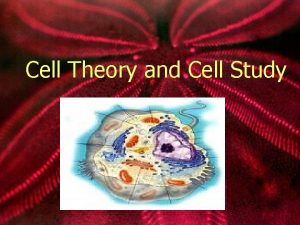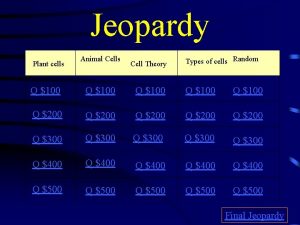Organization of the Cell Cell Theory Cells are
















































































































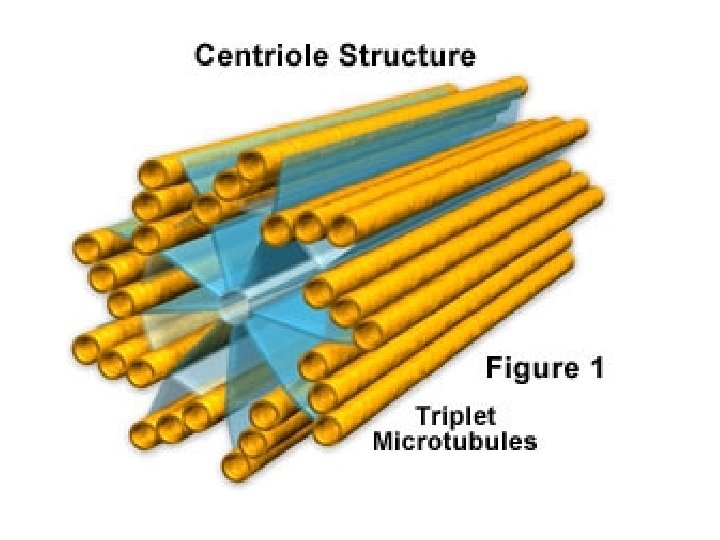

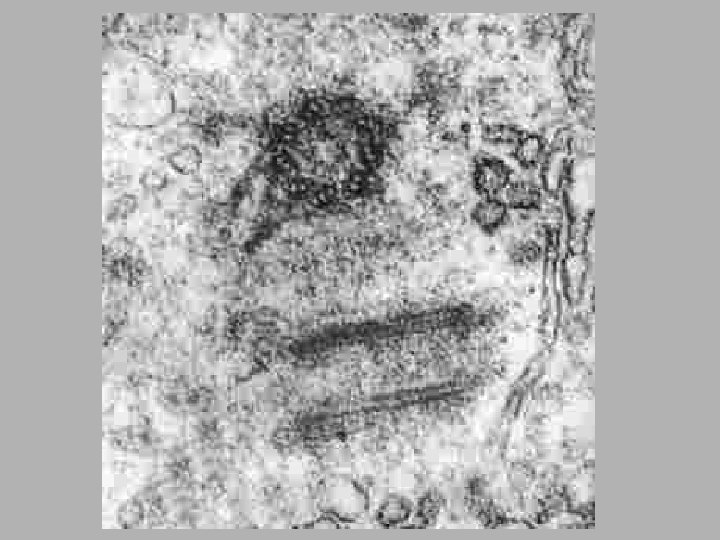
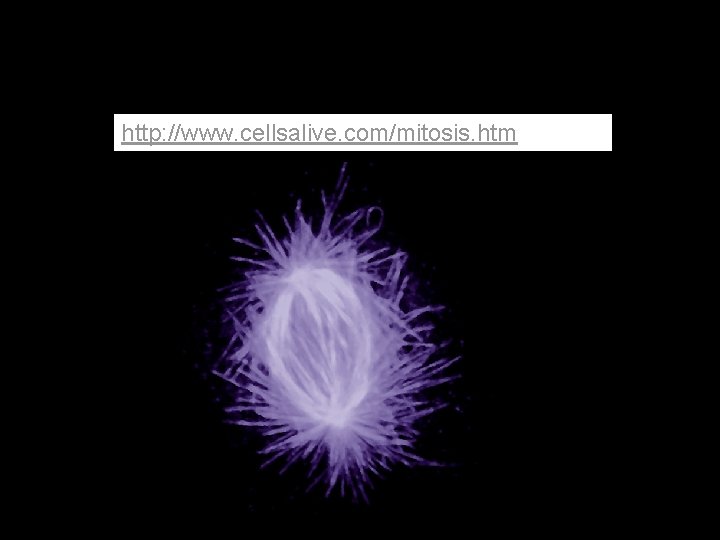
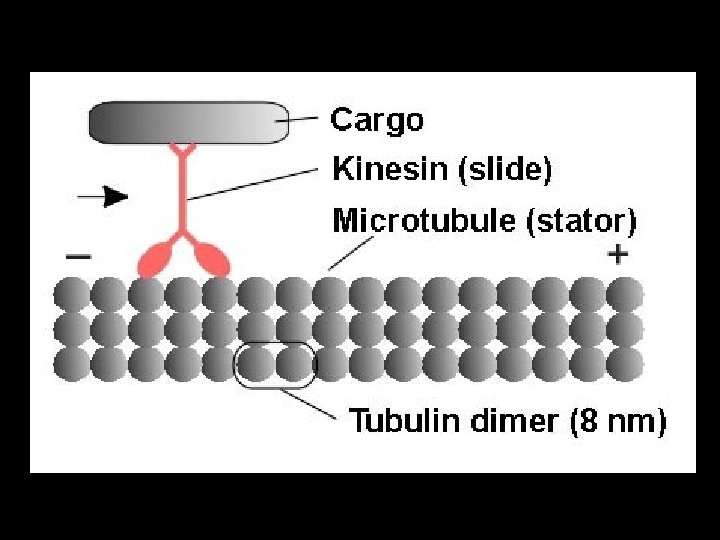
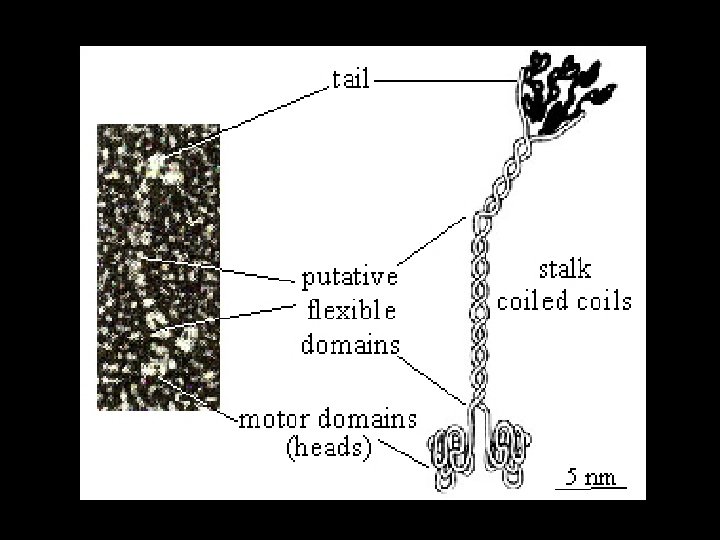
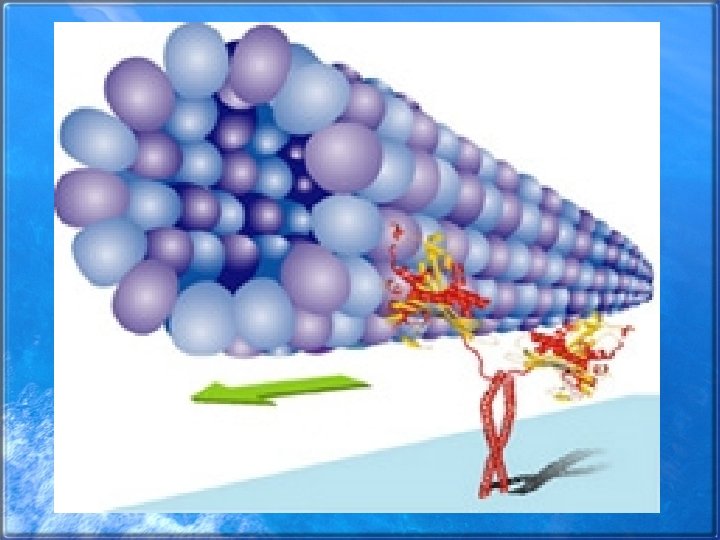
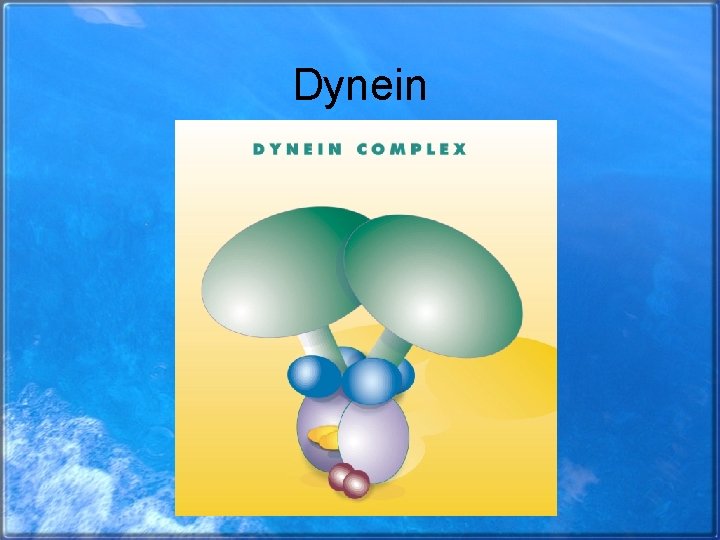
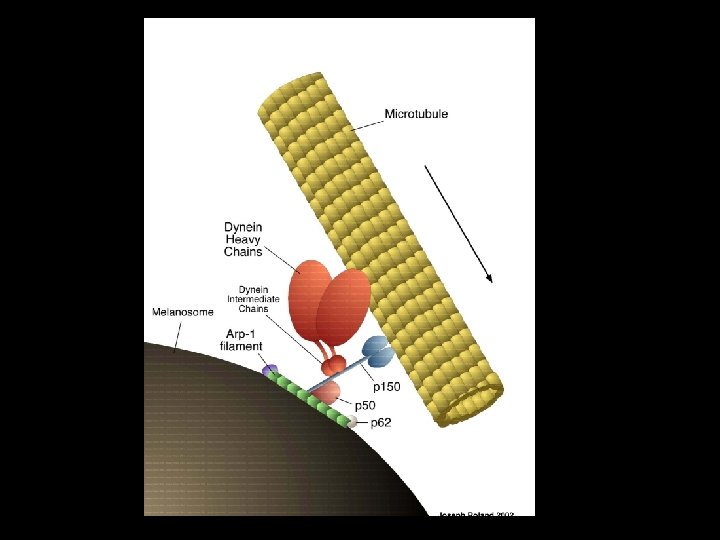

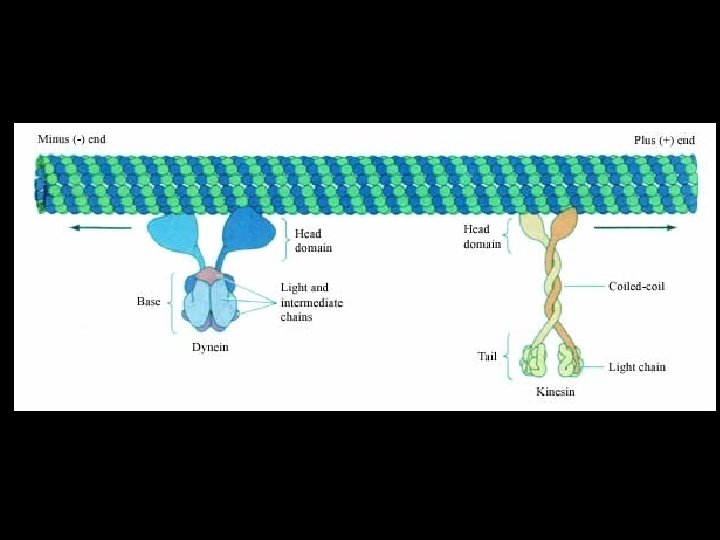
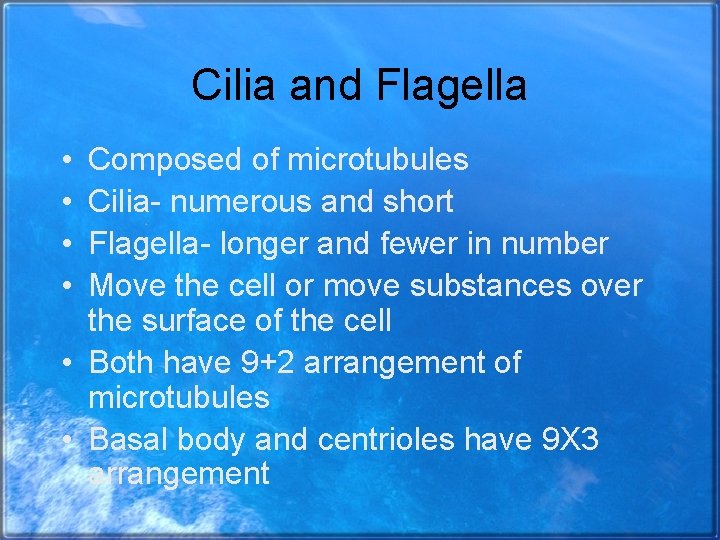
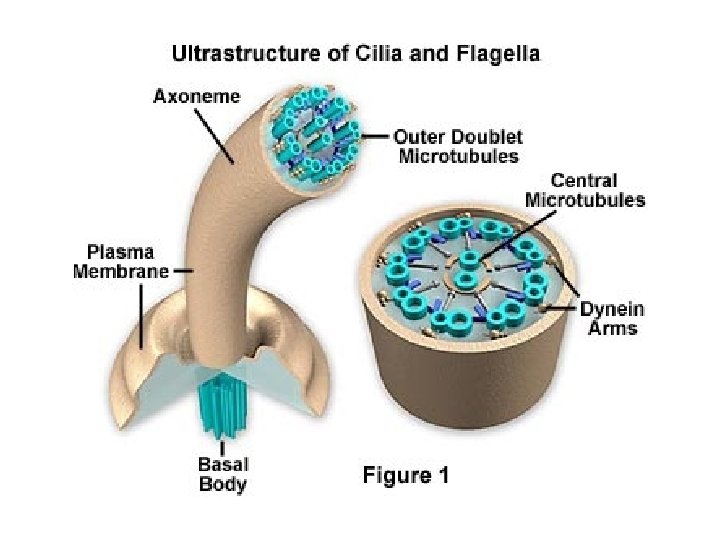
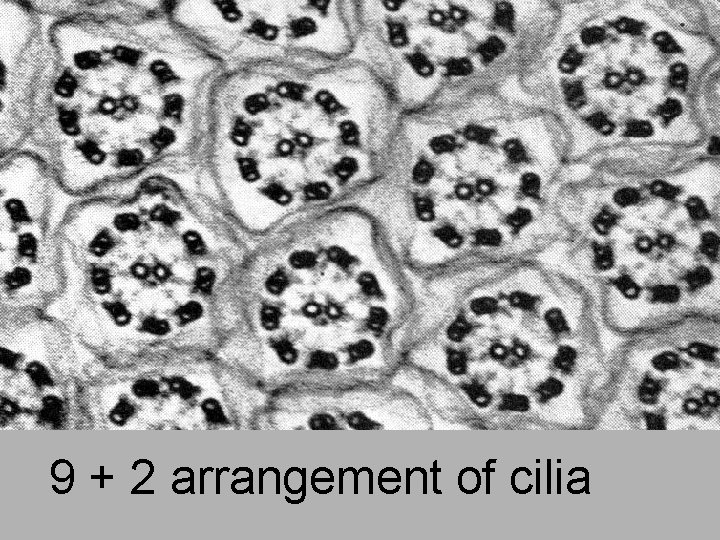
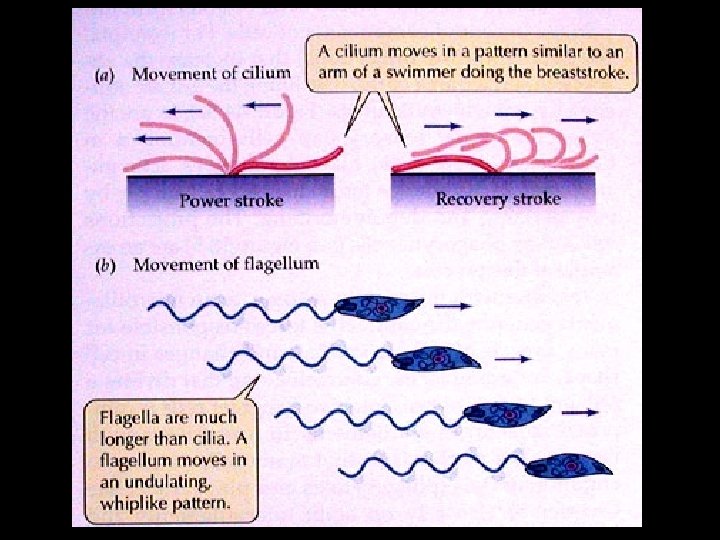
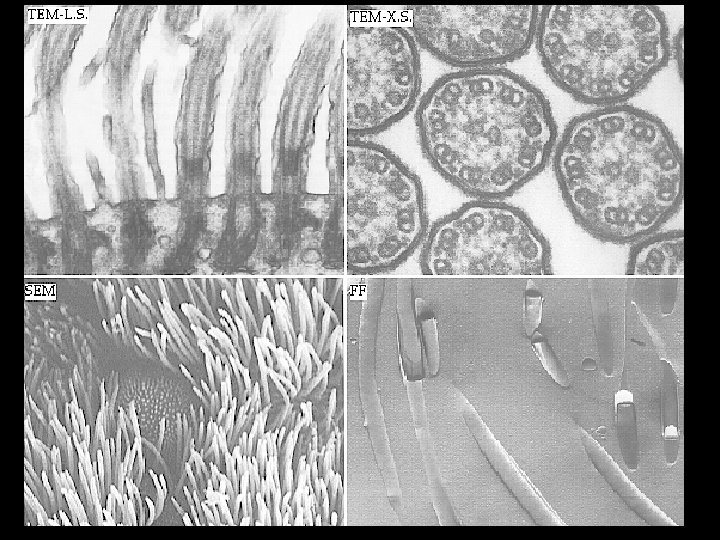
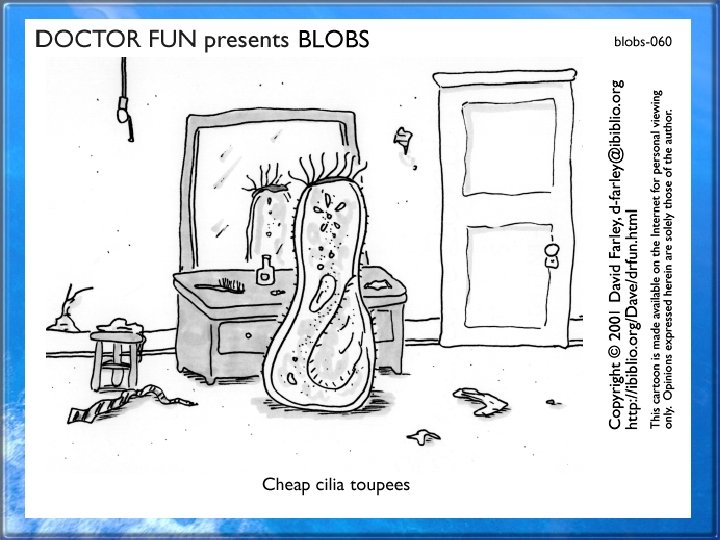
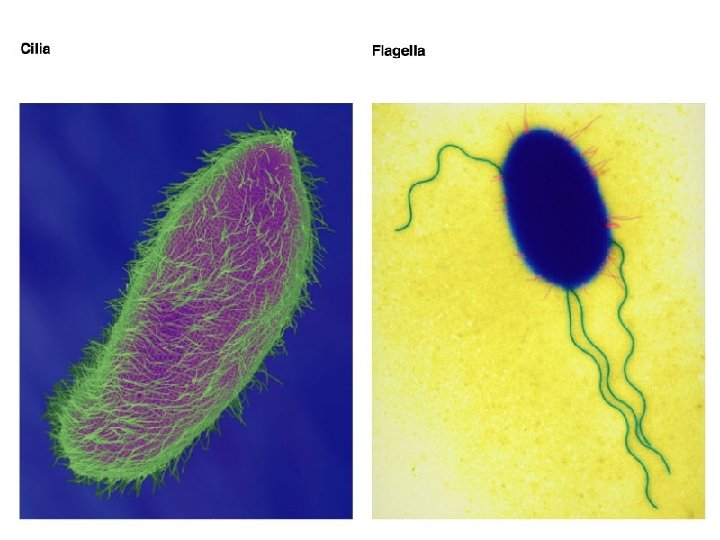
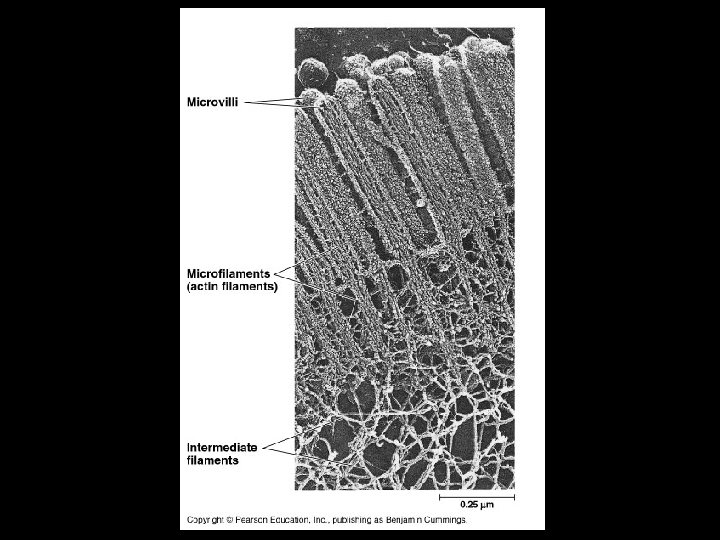
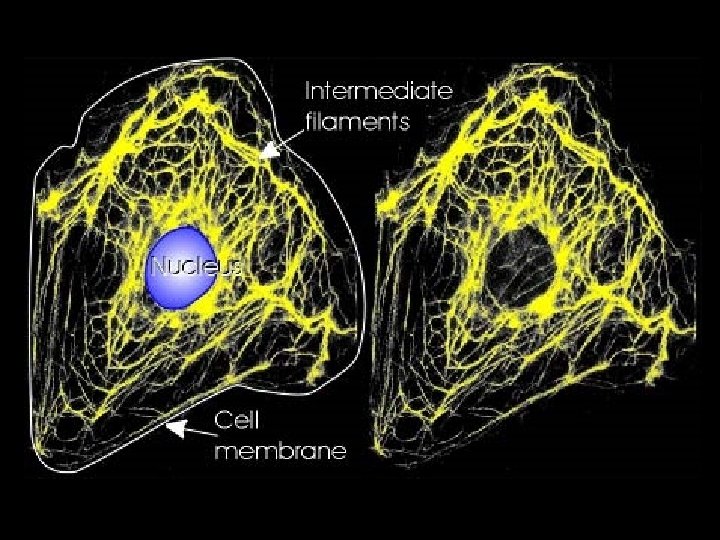
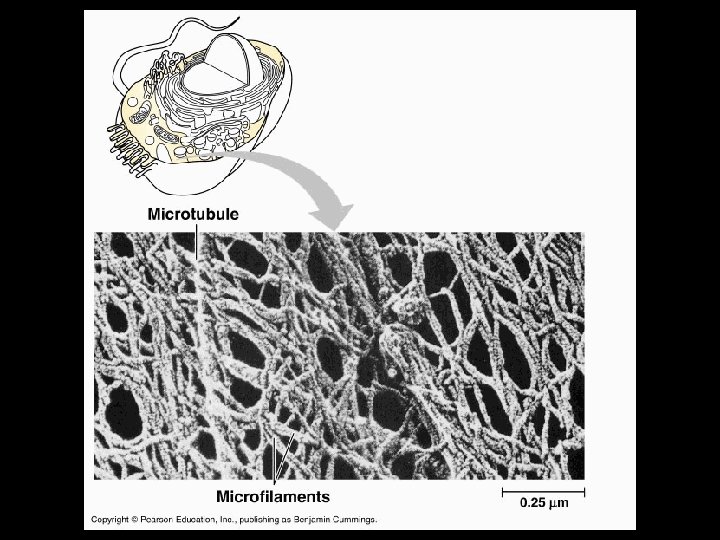
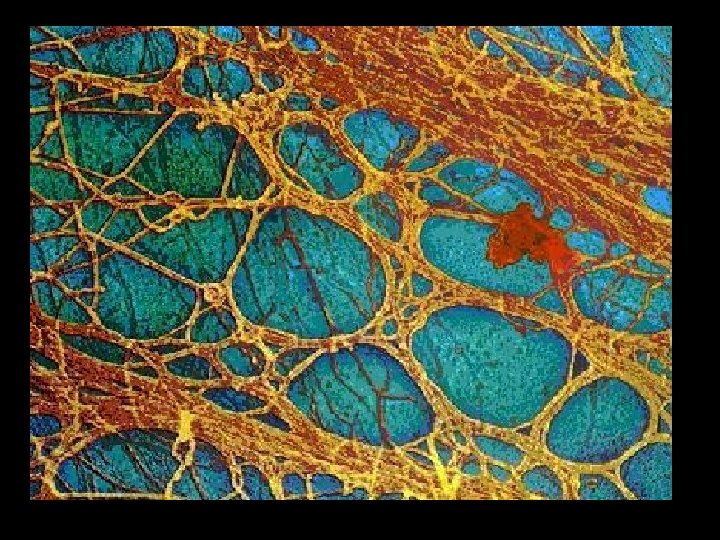
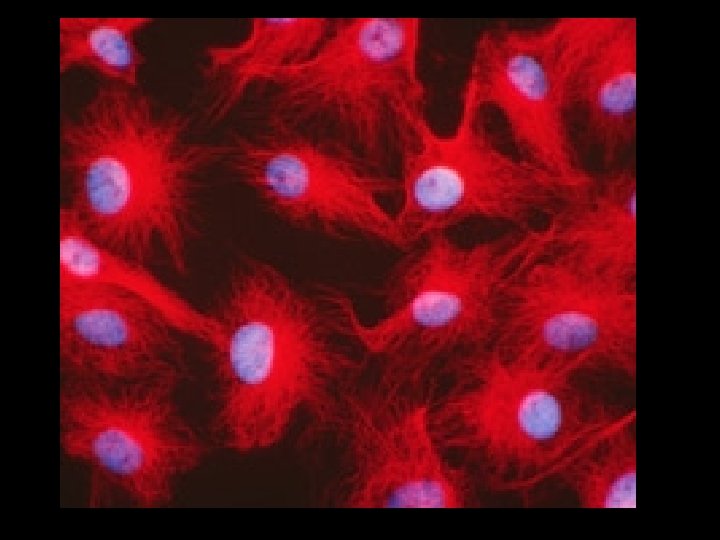
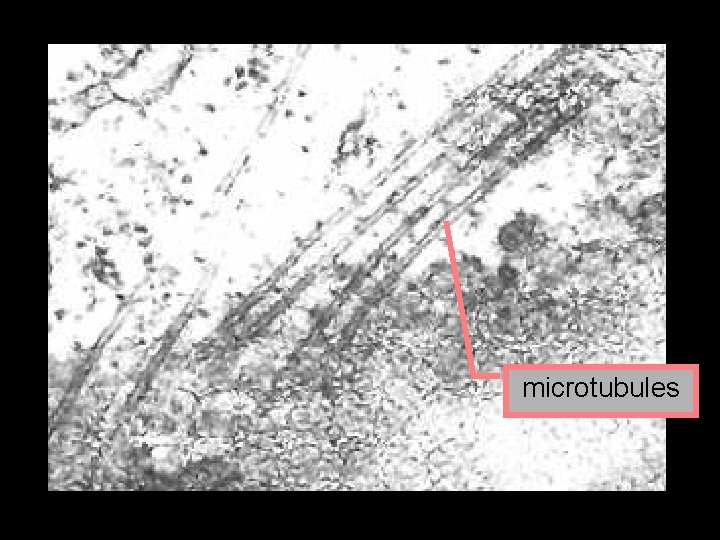
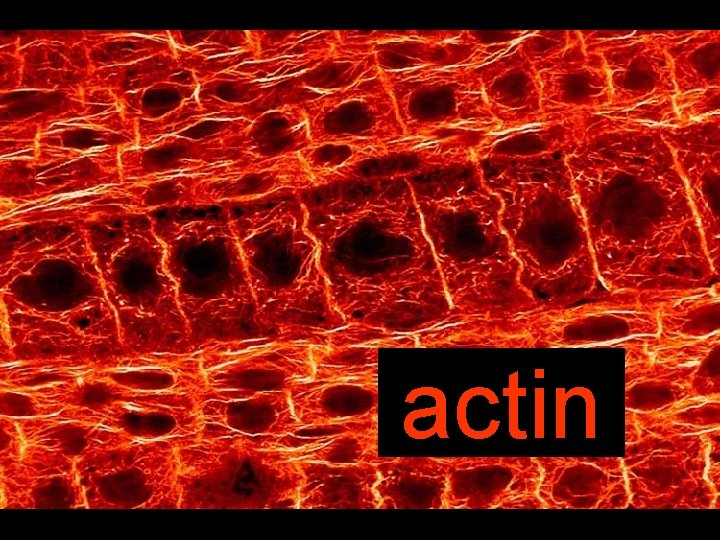
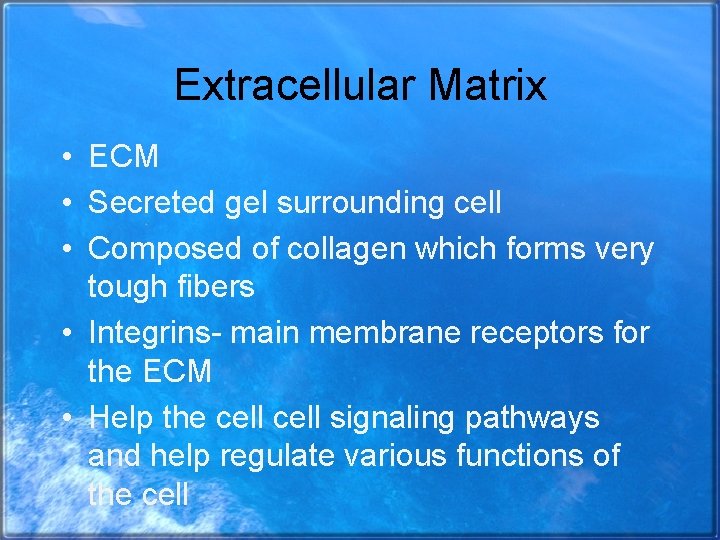
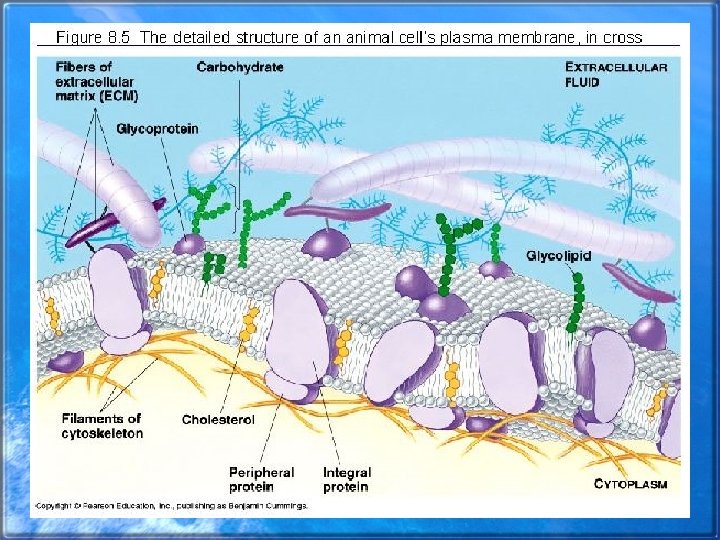
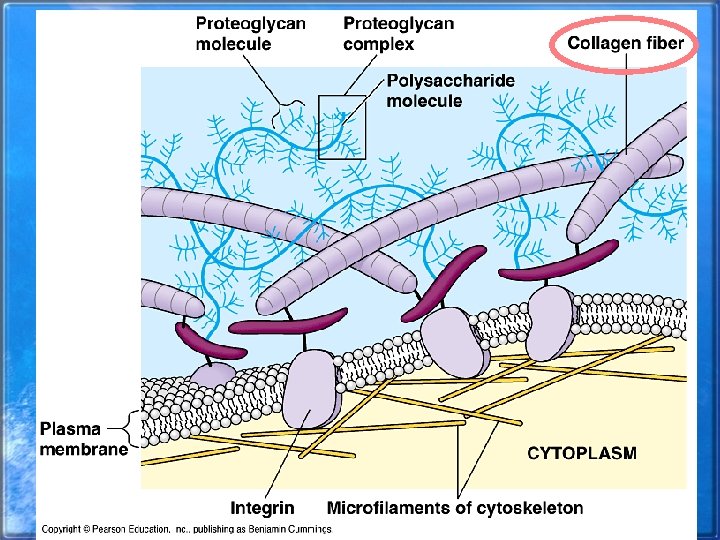
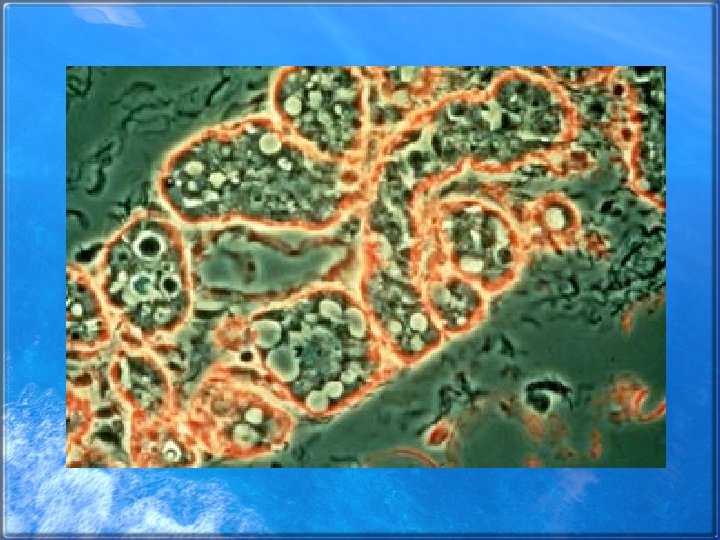
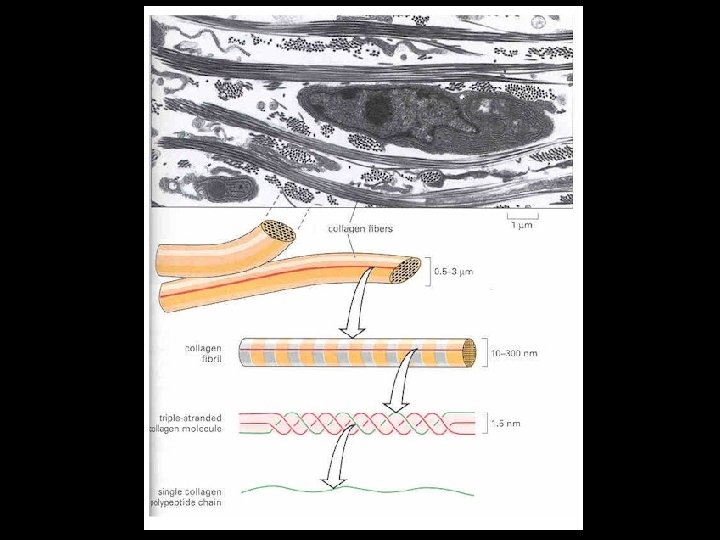
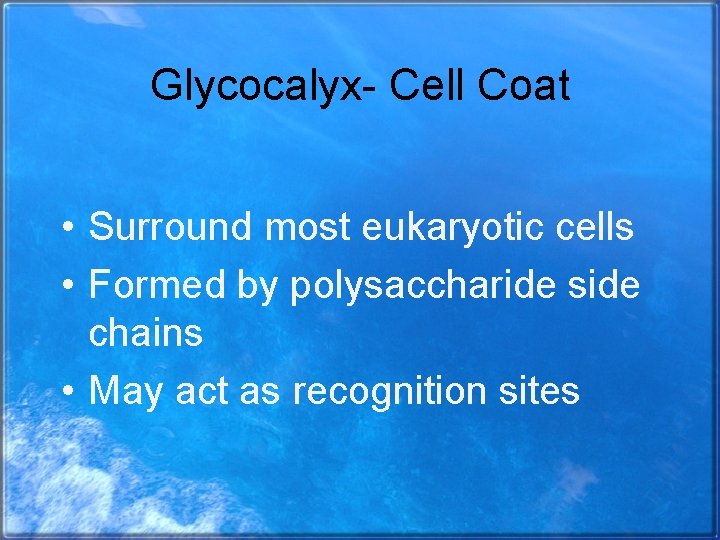
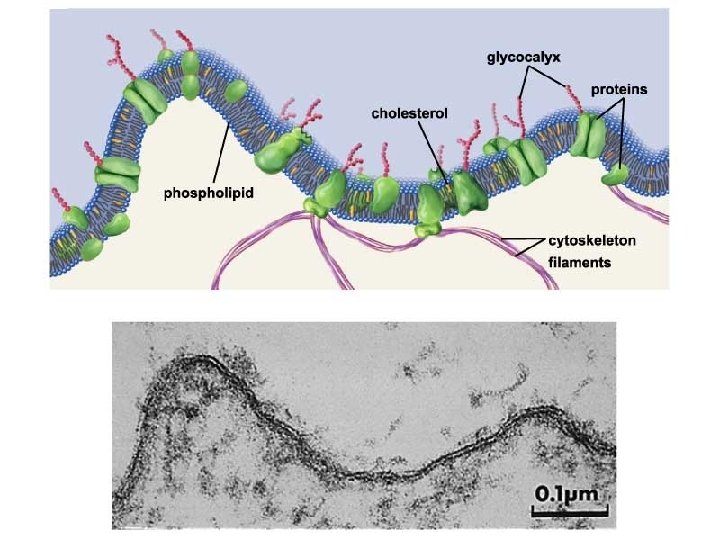
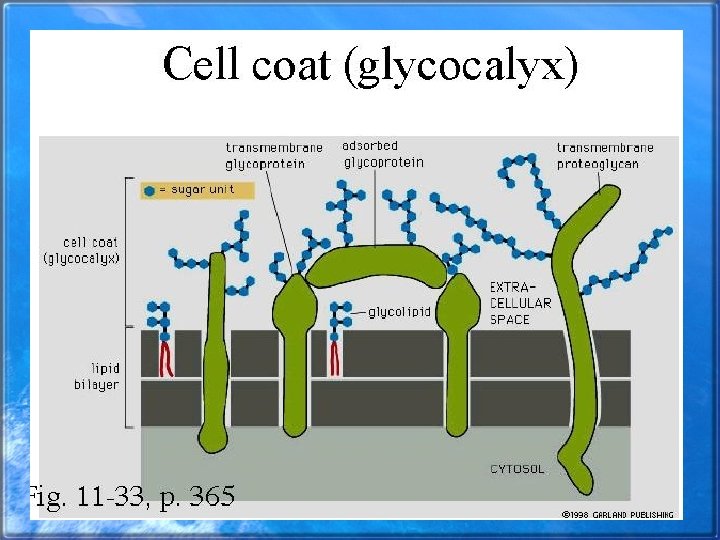


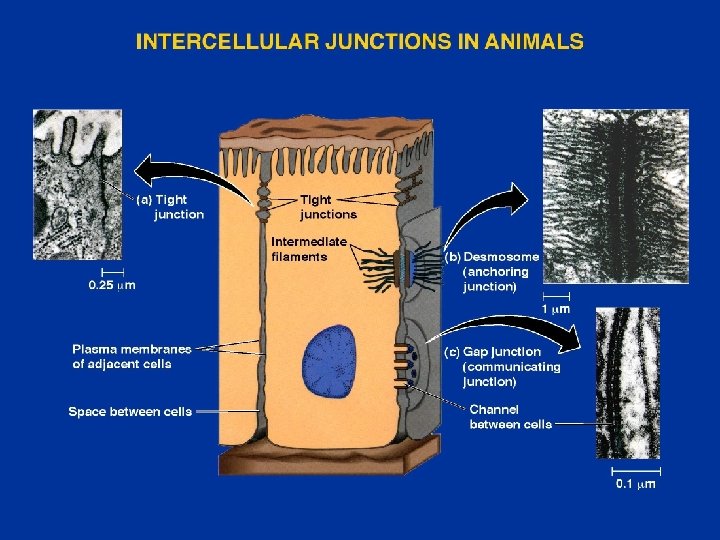


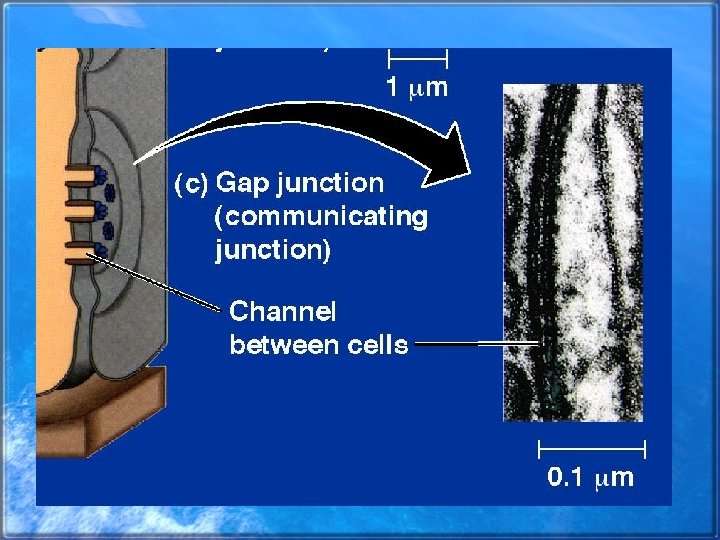
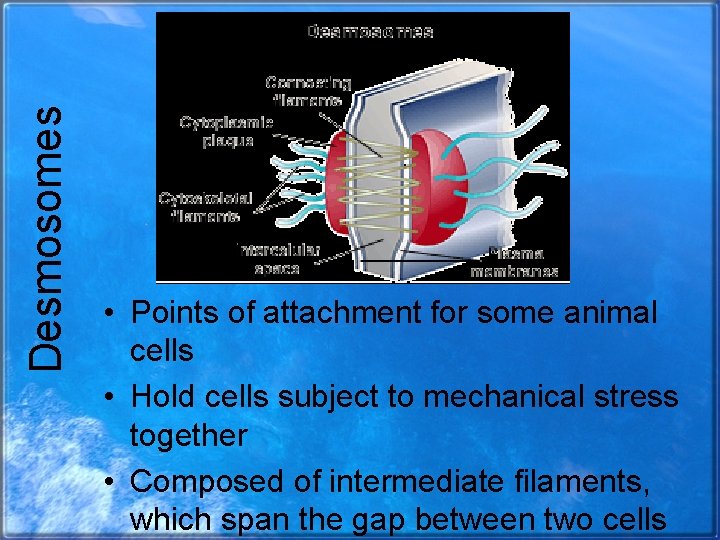
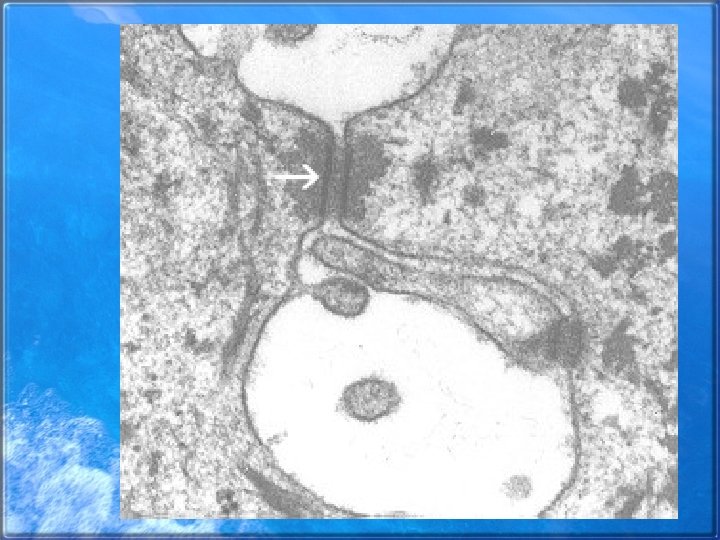
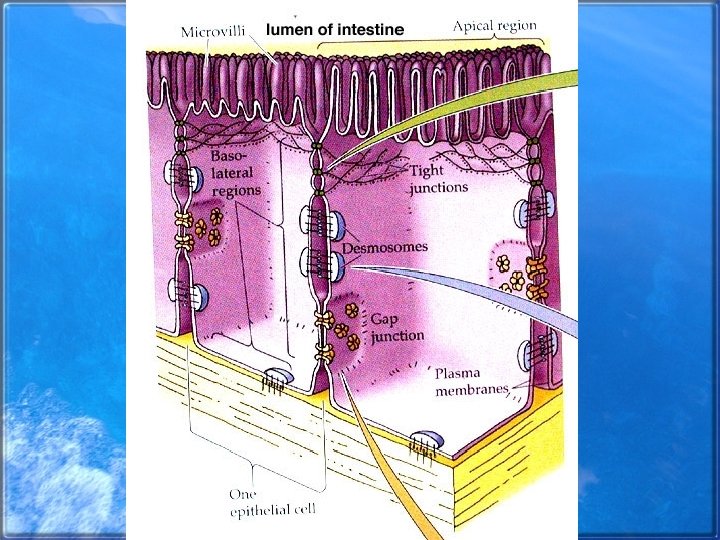
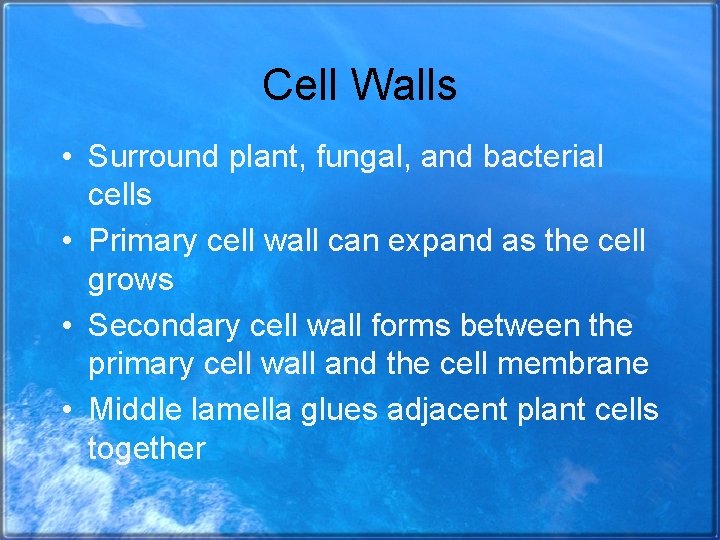
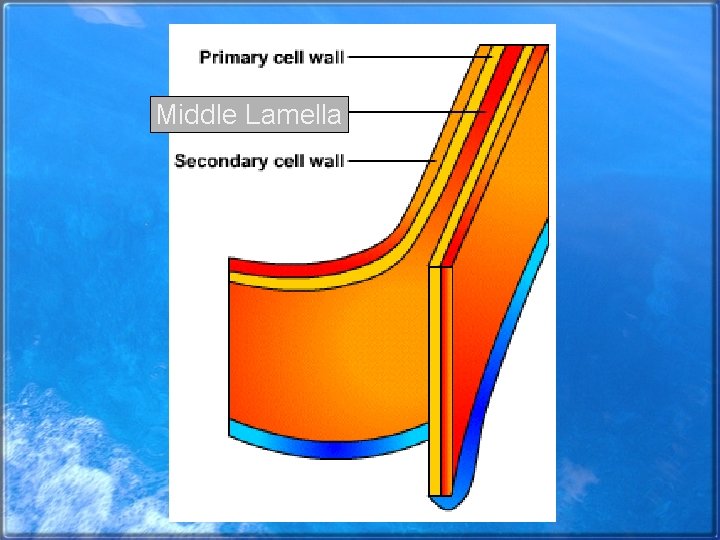
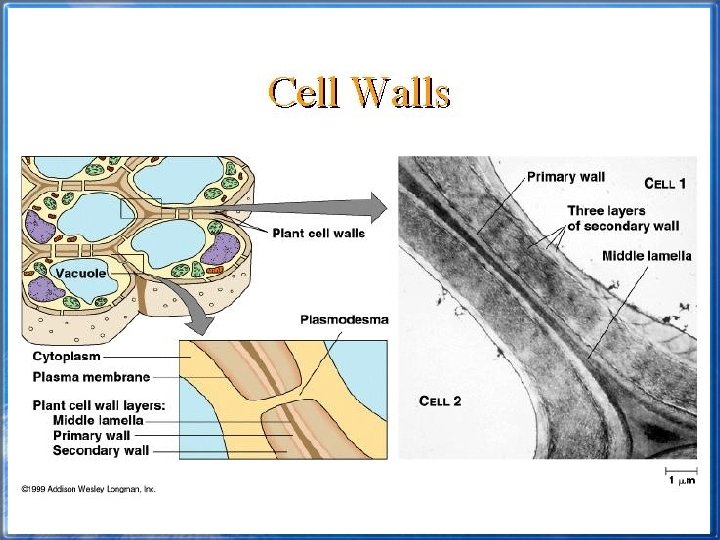
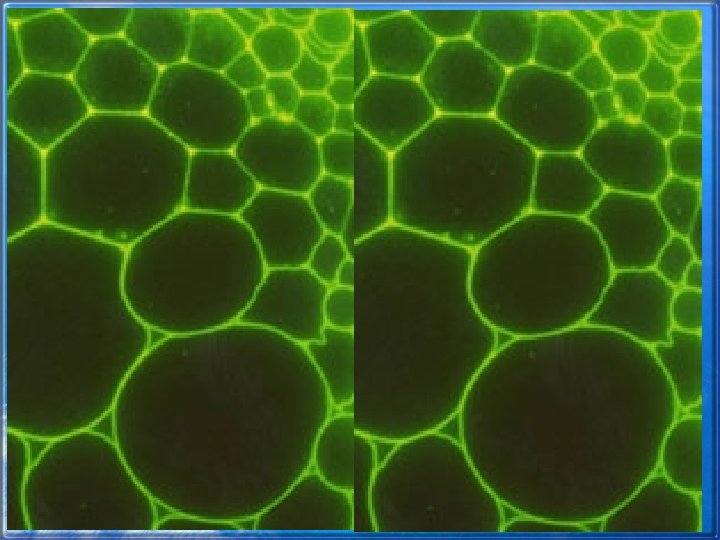
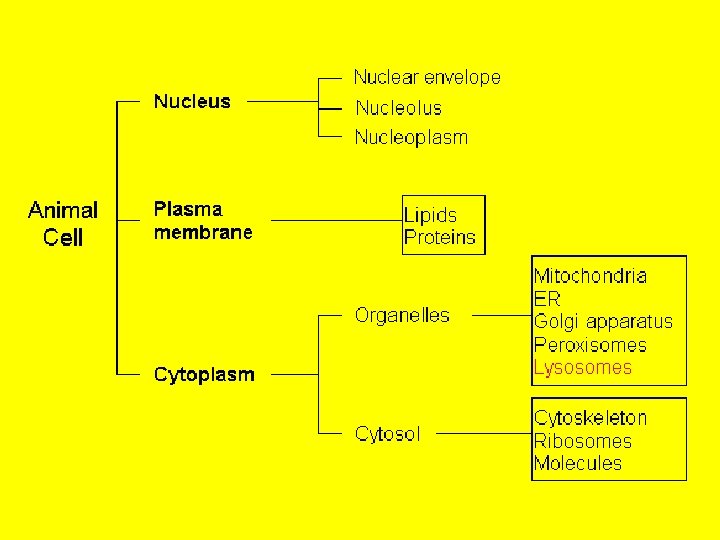
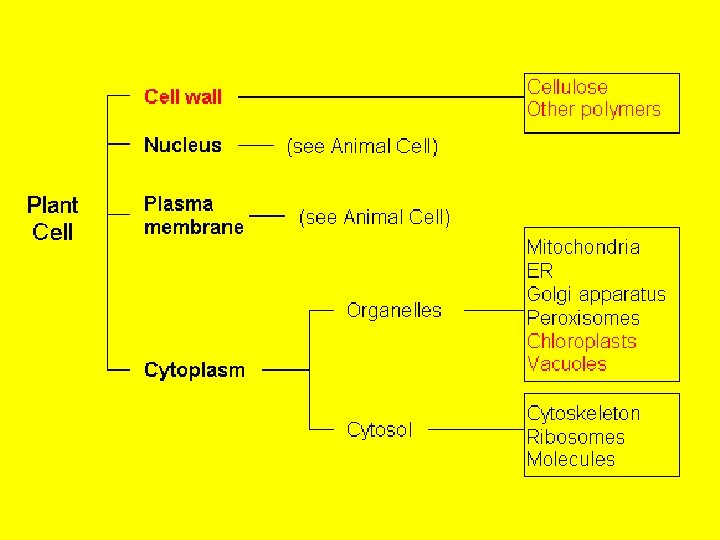
- Slides: 160

Organization of the Cell

Cell Theory Cells are the basic living units of organization and function in all organisms and all cells come from other cells

Cell Theory The players: Matthias Schleiden- German botanist (1838) Theodor Schwann- German zoologist (1839) Rudolph Virchow- German professor of pathology (1855)

Schleiden and Schwann The first to point out that all plants and animals are composed of cells. 1838

Rudolph Virchow The first to observe cells dividing 1855

History of the Microscope • Robert Hooke examined a thin piece of cork using a compound microscope- noticed the boxes in the thin slice and called them “cells” 1665 ?

History of the Microscope Anton van Leeuwenhoek viewed living cells with 200 magnification single lenses of his own construction. His important discoveries include bacteria, protists, blood cells, and sperm cells. 1670 s Dutch Scientist

Van Leeuwenhoek’s Microscope

1800

1860

1880

1890

1899

1908

1930

1951

1970

2004 Nikon ‘confocal’ microscope and, “No, I don’t know how much it costs. ”

Electron Microscope Invented in 1930 s by (believe it or not) German scientists Max Knott and Ernst Ruska

Transmission Electron Microscope • 2 -D Image • Image not living • 10, 000 X to 100, 000 X • Electron beam passes through the specimen • Specimen is thinly sliced

Scanning Electron Microscope • 3 -D imaging • Image not living • 1, 000 X-10, 000 X magnification • Image is coated with a thin film of metal and the electron beams are collected as they bounce off of the specimen

Prokaryotic Cells Bacteria are prokaryotic cells. All other known organisms consist of …. . Eukaryotic Cells

Prokaryotic Cells • Structurally simpler than eukaryotic cells • Nuclear material not enclosed in a membrane • Ribosomes smaller than Euk. • Lack of membrane bound organelles




Cheek cells bacteria

Eukaryotic Cells • • • Membrane bound organelles Cell Nucleus Ribosomes Endoplasmic reticulum Golgi complex Lysosomes Peroxisomes Vacuoles Mitochondria Chloroplasts

Membrane Bound Organelles The ‘stuff’ outside the nucleus and inside the cell membrane, suspended in cytoplasm

Membrane Bound Organelles Just to name a few ribosomes mitochondria Endoplasmic reticulum Vacuoles Peroxisomes Golgi complex Plastids Lysosomes

Cell Nucleus Contains nucleolus and chromosomes (DNA)

The Nucleus

Cell Nucleus • Typically in the center of the cell • Most cells have a single nucleus

Nuclear Envelope • Controls traffic between the nucleus and the cytoplasm • Pores in the nuclear membrane allow materials to pass in and out of the • nucleus


Nucleus – a closer look

Nuclear Envelope

EM View of Envelope

A closer look at the envelope

Nuclear Lamina • Inside the nucleus • Formed by intermediate filaments • Important in the timing of the disorganization of the membrane during cell division and the ensuing redevelopment

Lamina

Chromatin • When dividing, DNA takes the form of chromosomes • When not dividing, the DNA takes a looser form called chromatin

Loose Chromatin

Ribosomal Subunits • Eukaryotic ribosomal subunits are assembled in the nucleolus • Ribosomes are composed of two subunits

Ribosomes • Ribosomes manufacture proteins • Ribosomes may be free or may be attached to the endoplasmic reticulum


Endoplasmic Reticulum

Endoplasmic Reticulum • Major manufacturing center- proteins • Extends from the nuclear membrane into the cytoplasm • Lumen- the space enclosed by the ER- typical intracellular membrane

The Cytosol side of the ER may be studded with ribosomes

Rough ER • Site of protein synthesis • Proteins formed may be transferred to other sites within the cell in transport vesicles

Transport vesicles

Smooth ER • Lacks ribosomes • Lipid production • Detoxifying chemical agent


Golgi Complex • Cis face functions in receiving materials • The Trans face is directed toward the plasma membrane • Function: processing, sorting and modifying proteins • The process product is then passed to other organelles or to the plasma membrane • Manufactures lysosomes

Golgi Complex- Cis and Trans Face University of texas medical school

Convex shape




Lysosomes • Compartments for digestion • Small sacs filled hydrolytic enzymes • Primary lysosomes bud from the Golgi complex • Involved in apoptosis (programmed cell death) – Inappropriate apoptosis may be involved in many different catastrophic illnesses







Peroxisomes • Metabolize small organic compounds • Transfer hydrogen from various compounds to oxygen, forming hydrogen peroxide • Catalase splits hydrogen peroxide rendering it harmless

Peroxisomes • Common in cells that synthesize, store, or degrade lipids • Plant cells have specialized peroxisomes called glyoxysomes

Peroxisome Functions: • metabolism of free oxygen radicals; • synthesis of cholesterol and ether lipids; • bile acid formation; • catabolism of long chain fatty acids; • catabolism of purines, prostaglandins, leucotriens; • alcohol detoxification in liver

Some interesting facts about peroxisomes are: • Human congenital diseases associated w/ absence of peroxisomes and/or dysfunction of their enzymes • many chemicals (drugs, industrial pollutants) induce a marked proliferation of peroxisomes; • prolonged Tx w/ most proliferators induce malignant hepatic tumors




Vacuoles • Large, fluid filled sacs • Carry out variety of functions – In plants & fungi, vacuoles carry out many of the functions of the lysosome – Allow plants to increase in size • Bound by a membranous tonoplast • May store toxins or pigments • Protists have vacuoles that are involved in digestions and secretion







Mitochondria • Energy converting organelle- site of aerobic respiration • Double membrane bound • Matrix- inside of the inner membrane • Cristae- the foldings of the inner membrane, providing a large surface area • Mutations in mitochondrial DNA have been linked to several genetic diseases • Mitochondria also affect health by leaking electrons, which form free radicals, into the cell


Outer membrane lets many Molecules through, but inner membrane is very selective






Chloroplasts • Convert light energy into chemical energy through photosynthesis • Pigments like chlorophylls are specialized for photosynthesis • Double membrane bound • Develop from proplastids • Chromoplasts contain pigments and are common in petals and ripe fruit • Leukoplasts lack pigments and may store starch

Fluid filled area Contains enzymes responsible for producing carbohydrates from carbon dioxide and water

Thylakoids are involved with producing ATP. This is where the chlorophyll is.



Would you recognize these structures as chloroplasts? How?






Proplastids that will turn into amyloplasts

Cytoskeleton • Provides for cell shape and allows movement • Classifying elements of cytoskeleton by size – Microfilaments- smallest – Intermediate filaments – Microtubules- largest





Hollow cylinders


Microtubules are in green. Actin is in red. DNA is blue.



MTOC Microtubule Organizing Center- Centrosome





http: //www. cellsalive. com/mitosis. htm




Dynein




Cilia and Flagella • • Composed of microtubules Cilia- numerous and short Flagella- longer and fewer in number Move the cell or move substances over the surface of the cell • Both have 9+2 arrangement of microtubules • Basal body and centrioles have 9 X 3 arrangement


9 + 2 arrangement of cilia





Microfilaments





microtubules

actin

Extracellular Matrix • ECM • Secreted gel surrounding cell • Composed of collagen which forms very tough fibers • Integrins- main membrane receptors for the ECM • Help the cell signaling pathways and help regulate various functions of the cell





Glycocalyx- Cell Coat • Surround most eukaryotic cells • Formed by polysaccharide side chains • May act as recognition sites




Junctions between Cells • • Form strong connections Prevent passage of materials Establish communication Animal cell junctions – Anchoring (desmosomes and adhering junctions – Tight junctions – Gap junctions • Plant Cell junction – plasmodesmata





Desmosomes • Points of attachment for some animal cells • Hold cells subject to mechanical stress together • Composed of intermediate filaments, which span the gap between two cells



Cell Walls • Surround plant, fungal, and bacterial cells • Primary cell wall can expand as the cell grows • Secondary cell wall forms between the primary cell wall and the cell membrane • Middle lamella glues adjacent plant cells together

Middle Lamella




 Antigentest åre
Antigentest åre Levels of biological organization
Levels of biological organization Sphenoid paranasal sinus
Sphenoid paranasal sinus Papillary duct of bellini
Papillary duct of bellini Thyroid parafollicular cells
Thyroid parafollicular cells How are mitosis and meiosis similar
How are mitosis and meiosis similar Somatic cells vs germ cells
Somatic cells vs germ cells Chlorocruorin
Chlorocruorin Eukaryotic life
Eukaryotic life Comparing animal and plant cells venn diagram
Comparing animal and plant cells venn diagram Prokaryotic cell
Prokaryotic cell Why did robert hooke name cells “cells”?
Why did robert hooke name cells “cells”? Masses of cells form and steal nutrients from healthy cells
Masses of cells form and steal nutrients from healthy cells Younger cells cuboidal older cells flattened
Younger cells cuboidal older cells flattened What cell type
What cell type Which organisms are prokaryotes
Which organisms are prokaryotes Nondisjunction in meiosis
Nondisjunction in meiosis Cells cells they're made of organelles meme
Cells cells they're made of organelles meme Chapter 4 cell theory and cell study
Chapter 4 cell theory and cell study Process organization in computer organization
Process organization in computer organization Point by point vs block organization
Point by point vs block organization Germ cell vs somatic cells
Germ cell vs somatic cells Collections of specialized cells and cell products
Collections of specialized cells and cell products Hình ảnh bộ gõ cơ thể búng tay
Hình ảnh bộ gõ cơ thể búng tay Ng-html
Ng-html Bổ thể
Bổ thể Tỉ lệ cơ thể trẻ em
Tỉ lệ cơ thể trẻ em Chó sói
Chó sói Tư thế worms-breton
Tư thế worms-breton Chúa yêu trần thế
Chúa yêu trần thế Các môn thể thao bắt đầu bằng từ đua
Các môn thể thao bắt đầu bằng từ đua Thế nào là hệ số cao nhất
Thế nào là hệ số cao nhất Các châu lục và đại dương trên thế giới
Các châu lục và đại dương trên thế giới Công thức tiính động năng
Công thức tiính động năng Trời xanh đây là của chúng ta thể thơ
Trời xanh đây là của chúng ta thể thơ Cách giải mật thư tọa độ
Cách giải mật thư tọa độ Làm thế nào để 102-1=99
Làm thế nào để 102-1=99 Phản ứng thế ankan
Phản ứng thế ankan Các châu lục và đại dương trên thế giới
Các châu lục và đại dương trên thế giới Thể thơ truyền thống
Thể thơ truyền thống Quá trình desamine hóa có thể tạo ra
Quá trình desamine hóa có thể tạo ra Một số thể thơ truyền thống
Một số thể thơ truyền thống Cái miệng xinh xinh thế chỉ nói điều hay thôi
Cái miệng xinh xinh thế chỉ nói điều hay thôi Vẽ hình chiếu vuông góc của vật thể sau
Vẽ hình chiếu vuông góc của vật thể sau Nguyên nhân của sự mỏi cơ sinh 8
Nguyên nhân của sự mỏi cơ sinh 8 đặc điểm cơ thể của người tối cổ
đặc điểm cơ thể của người tối cổ V cc
V cc Vẽ hình chiếu đứng bằng cạnh của vật thể
Vẽ hình chiếu đứng bằng cạnh của vật thể Fecboak
Fecboak Thẻ vin
Thẻ vin đại từ thay thế
đại từ thay thế điện thế nghỉ
điện thế nghỉ Tư thế ngồi viết
Tư thế ngồi viết Diễn thế sinh thái là
Diễn thế sinh thái là Dot
Dot Số nguyên tố là
Số nguyên tố là Tư thế ngồi viết
Tư thế ngồi viết Lời thề hippocrates
Lời thề hippocrates Thiếu nhi thế giới liên hoan
Thiếu nhi thế giới liên hoan ưu thế lai là gì
ưu thế lai là gì Hươu thường đẻ mỗi lứa mấy con
Hươu thường đẻ mỗi lứa mấy con Sự nuôi và dạy con của hươu
Sự nuôi và dạy con của hươu Sơ đồ cơ thể người
Sơ đồ cơ thể người Từ ngữ thể hiện lòng nhân hậu
Từ ngữ thể hiện lòng nhân hậu Thế nào là mạng điện lắp đặt kiểu nổi
Thế nào là mạng điện lắp đặt kiểu nổi Organisational environment theory
Organisational environment theory Neo classical organizational theory
Neo classical organizational theory Community organization theory
Community organization theory Classical theory of organization
Classical theory of organization Power and politics organization theory
Power and politics organization theory Organization theory
Organization theory Cell city worksheet
Cell city worksheet Denuding tower
Denuding tower Site:slidetodoc.com
Site:slidetodoc.com Prokaryotic reproduction
Prokaryotic reproduction Venn diagram plant and animal cells
Venn diagram plant and animal cells The cell reaction for the zn-h2 cell is
The cell reaction for the zn-h2 cell is Dry cell vs wet cell
Dry cell vs wet cell What is the function of cell wall in plant cell
What is the function of cell wall in plant cell Vacuole function
Vacuole function What is the main function of a vacuole
What is the main function of a vacuole Cell wall cell membrane
Cell wall cell membrane Cell strain
Cell strain Cell line vs cell strain
Cell line vs cell strain Cell city introduction
Cell city introduction Primary and secondary cells
Primary and secondary cells Differences between plant animal and bacterial cells
Differences between plant animal and bacterial cells Cell-cell junction
Cell-cell junction Cell-cell junction
Cell-cell junction Which organelle prepares proteins for specific jobs
Which organelle prepares proteins for specific jobs Events of the cell cycle
Events of the cell cycle Prokaryotic cell and eukaryotic cell
Prokaryotic cell and eukaryotic cell Carbohydrate side chain
Carbohydrate side chain Cell organelle graphic organizer answer key
Cell organelle graphic organizer answer key Idealized plant cell
Idealized plant cell Walker cell and hadley cell
Walker cell and hadley cell Cell cycle and cell division
Cell cycle and cell division Biology.arizona.edu/cell bio/activities/cell cycle/01.html
Biology.arizona.edu/cell bio/activities/cell cycle/01.html Cell cycle phases in order
Cell cycle phases in order Cell contents assignment to a non-cell array object
Cell contents assignment to a non-cell array object Voltaic vs electrolytic cell
Voltaic vs electrolytic cell What is the gooey liquid in plant and animal cells
What is the gooey liquid in plant and animal cells What is it about
What is it about Cell theory timeline
Cell theory timeline 3 parts of the cell theory
3 parts of the cell theory What are three parts of the cell theory
What are three parts of the cell theory Todays final jeopardy
Todays final jeopardy 3 parts of the cell theory
3 parts of the cell theory Tenets of cell theory
Tenets of cell theory What are three parts of the cell theory
What are three parts of the cell theory Chapter 7 section 4 cellular transport
Chapter 7 section 4 cellular transport 3 parts of the cell theory
3 parts of the cell theory Hans and zacharias janssen cell theory timeline
Hans and zacharias janssen cell theory timeline Robert hooke timeline
Robert hooke timeline What are the 3 principles of cell theory?
What are the 3 principles of cell theory? Robert hooke cell theory
Robert hooke cell theory Modern cell theory
Modern cell theory Cell theory timeline
Cell theory timeline Cell theory 3 parts pictures
Cell theory 3 parts pictures What are three parts of the cell theory
What are three parts of the cell theory 3 parts of the cell theory
3 parts of the cell theory What are the 3 parts of the cell theory
What are the 3 parts of the cell theory What are the three statements of the cell theory
What are the three statements of the cell theory Cell theory definition
Cell theory definition Apical cell theory
Apical cell theory Mitochondria double membrane function
Mitochondria double membrane function The 3 principles of cell theory
The 3 principles of cell theory Anton van leeuwenhoek cell theory
Anton van leeuwenhoek cell theory Chapter 7 section 1 cell discovery and theory
Chapter 7 section 1 cell discovery and theory Plant and animal cells foldable
Plant and animal cells foldable History of cell
History of cell Mitochondria structure and function
Mitochondria structure and function Cell theory
Cell theory Cell theory rap
Cell theory rap Whats the cell theory
Whats the cell theory Http://ed.ted.com/lessons/the-wacky-history-of-cell-theory
Http://ed.ted.com/lessons/the-wacky-history-of-cell-theory Robert hooke 1665
Robert hooke 1665 Cell theory cer
Cell theory cer Cell theory bell ringer
Cell theory bell ringer Antonie van leeuwenhoek cell theory
Antonie van leeuwenhoek cell theory According to the cell theory —
According to the cell theory — Cell theory
Cell theory Cell theory bell ringer
Cell theory bell ringer Whats a cell theory
Whats a cell theory La scoperta della cellula
La scoperta della cellula Matthias schleiden cell theory contribution
Matthias schleiden cell theory contribution Francesco redi cell theory
Francesco redi cell theory History of cell
History of cell Whats a cell
Whats a cell Anton van leeuwenhoek cell theory 1673
Anton van leeuwenhoek cell theory 1673 Robert hooke 1665 cell theory
Robert hooke 1665 cell theory Cell theory
Cell theory Antonie van leeuwenhoek cell theory
Antonie van leeuwenhoek cell theory Cell theory bell ringer
Cell theory bell ringer Cell theory
Cell theory Scientists who contributed to the cell theory
Scientists who contributed to the cell theory Leeuwenhoek cell theory
Leeuwenhoek cell theory Robert hooke 1665 cell theory
Robert hooke 1665 cell theory Modern cell theory
Modern cell theory Outline one therapeutic use of stem cells
Outline one therapeutic use of stem cells Hans and zacharias janssen
Hans and zacharias janssen



